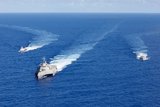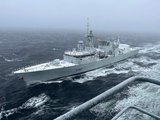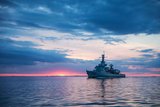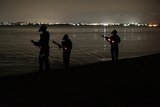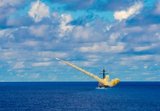Blighter C400 series radar introduced
Blighter Surveillance Systems has introduced a new member of its Blighter radar portfolio designed for coastal security, the Blighter C400.
The Blighter C400 series is a modular, solid-state non-rotating e-scan advanced Doppler radar designed specifically for the detection of small, slow moving and uncooperative targets that are often undetectable by traditional coastal surveillance systems and maritime radars. Targets with a radar cross section of 1m² can be detected at a range of up to 11km even in poor weather, low light and rough seas.
The radar uses advanced Doppler signal processing, low power passive electronically scanned array and frequency modulated continuous wave technologies. The radar also has a built-in static target detector, sea clutter filter with low false alarm rate, and a ‘shadow boost’ feature that gives the radar minimum detection range of 10 metres to enable boats to be detected as they land, even when close to the radar.
Mark Radford, CEO, Blighter Surveillance Systems, said: ‘The principal challenge for coastal security system integrators is detecting unwanted intruders using small and slow moving boats during poor environmental conditions. That’s because smugglers, terrorists, pirates and illegals exploit the weather conditions to evade detection knowing that sensors are often compromised during heavy rains and at high sea states.
‘However, we have designed the Blighter C400 coastal security radar to work in these conditions by developing techniques and algorithms for differentiating boats from waves and detecting very slow and static objects on the water surface, even in cluttered environments. Hence, we can detect a kayak, canoe, jet-ski, RIB or other small boat alongside larger ships even in a busy harbour or port.’
The radar can be used as part of a larger coastal security system incorporating day/night and fog penetrating electro-optical camera systems, automatic identification systems, other boat transponder/tracking systems and CCTV. These elements can all be controlled through the BlighterView HMI command and control software platform.
Applications include the protection of seaports, harbours, as well as land-based coastal assets such as oil and gas facilities, desalination plants, nuclear power stations and other high value assets. The radar can also be used for river and estuary monitoring in situations where bulky coastal surveillance radars are unsuitable.
Related Equipment in Defence Insight
More from Naval Warfare
-
![US Navy to acquire micro-uncrewed underwater vehicles for ISR and coastal data collection]()
US Navy to acquire micro-uncrewed underwater vehicles for ISR and coastal data collection
The Naval Supply Systems Command is seeking authorised resellers of JaiaBot uncrewed underwater vehicles and multivehicle pods. The platforms will support undergraduate education at the US Naval Academy.
-
![US Navy advances with the Harpoon Service Life Extension Programme]()
US Navy advances with the Harpoon Service Life Extension Programme
The US Navy plans to improve Harpoon’s anti-ship and land attack capabilities by equipping the missiles with sensors and technologies required for succeeding in future battlespace.
-
![Future of the Canadian Patrol Submarine Project is still unclear]()
Future of the Canadian Patrol Submarine Project is still unclear
The Canadian government remains tight-lipped on the timeline and funding required for the next steps of its Canadian Submarine Patrol Project, which should offer improved capabilities for the country’s navy.








